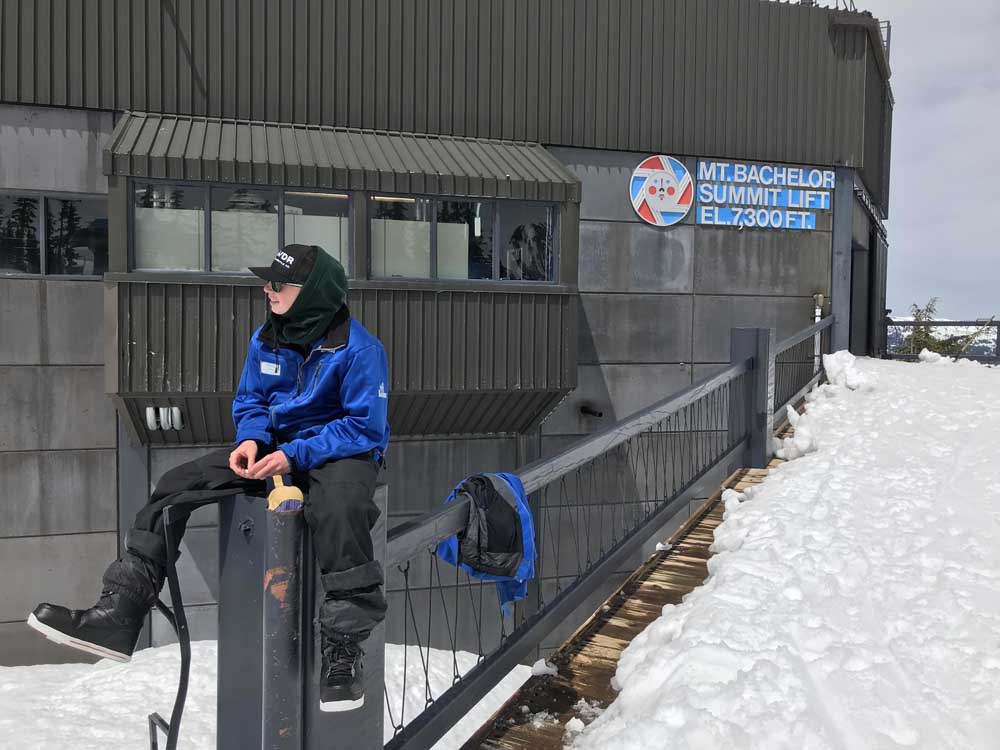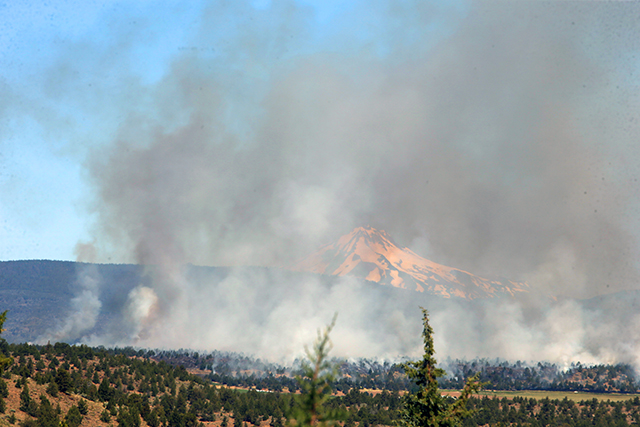Ski resort workers at higher risk for skin cancer
Published 12:00 am Monday, May 7, 2018

- Mt. Bachelor lift operator Jake Bowler, left, sits on a post while working at the bottom of the Summit Chair at Mt. Bachelor on May 4, 2018. (Andy Tullis/Bulletin photo)
Working outdoors at higher elevations, ski resort workers have a much higher risk of skin cancer than the general population. But most ski resorts do little more to prevent skin cancer than reminding their employees to wear sunscreen.
A recent initiative by the Huntsman Cancer Institute and University of Utah Health screened 394 ski resort employees at two Utah ski resorts. They diagnosed 38 workers — nearly 10 percent — with skin cancer, recommended biopsies for 20 percent and referred more than a third for further evaluation. Nationwide, melanoma occurs in 0.2 percent of people, while non-melanoma cancers affect about 1 percent of the population.
“If you look at our data, it’s pretty alarming,” said Dr. Christopher Hull, a dermatologist with the University of Utah who worked on the initiative. “It’s definitely not a minor thing.”
The numbers don’t represent a random sampling, as screening was voluntary. Workers who were suspicious about spots on their skin were probably more likely to sign up. But 41 percent of those screened said they wouldn’t have otherwise gone to a physician to have their skin checked.
“It was first come, first serve. We had bakers and indoor hotel employees,” Hull said. “But most of them, when they’re not working, they’re probably skiing, and when they’re not skiing, they’re probably hiking or biking.”
Utah has the highest incidence of melanoma in the nation, but Oregon ranks sixth. Deschutes County, with its high elevation and sunny weather, has the highest rate of any county in the state. Both states have a predominantly light-skinned population and an active year-round outdoor lifestyle.
Studies have shown that individuals who pursue outdoor sports have increased skin cancer rates, with skiers particularly at risk for squamous cell carcinoma, a type of skin cancer that is more common than melanoma but less deadly.
“We know that both UVA and UVB are important probably for melanoma, but UVB is the one that’s really implicated for the nonmelanoma skin cancers,” said Dr. Sancy Leachman, chair of dermatology at Oregon Health & Sciences University and director of the Melanoma Research Program at the Knight Cancer Center. “People who work outdoors a lot … that is increasing your risk.”
Ultraviolet radiation, especially UVB, is stronger at high altitudes and the snow provides a reflective surface that increases exposure to sunlight. One study found that skiers without sunscreen at 11,000 feet will start to develop a sunburn after only six minutes.
“It’s basically like little photons coming down from the sun like little bullets,” Leachman said. “It’s like Russian roulette. Did they hit the DNA in the right cell at the right time, and it stuck and it caused a mutation? And if so, how many mutations has that cell gotten?”
And the more sun exposure, the more chances that exposure is going to lead to cancer.
“But if you’re at a higher elevation … instead of shooting with a rifle, it’s like shooting with a machine gun,” Leachman said.
“You’re getting a lot more DNA damage per minute you’re outdoors.”
Hull says a rule of thumb is that UV radiation increases 6 percent for every thousand feet of elevation gain. That means exposure is nearly 40 percent higher at the base of Mount Bachelor than at sea level, and 54 percent higher at the summit. Light reflecting off the snow increases the exposure further.
Ski resort employees are at particularly high risk as they are often outdoors for much of the winter, and potentially year round.
“They’re obviously in an environment where they’re at higher elevations in their workplace, but also where they live,” said Dr. Will Delgado, a dermatologist with Bend Dermatology who specializes in removing skin cancers.
A Mt. Bachelor spokesman said the resort includes sun safety training as part of its mandatory season safety training program for all employees, encourages all department managers to include it in their periodic safety huddles and provides free sunscreen to staff.
Delgado says skin cancer risk goes up both with cumulative sun exposure and with every incidence of a blistering sunburn. Even a single tanning bed session increases the risk for skin cancers.
Delgado sees less of the raccoon eyes, ski-goggle tan phenomenon these days, but says people often neglect to protect themselves.
“I think people are pretty knowledgeable, but the steps they take may not be good enough,” he says. “They may not be reapplying sunscreen or covering up, especially on a bluebird day.”
Organizers of the ski worker skin cancer program, dubbed Sun Safety on the Slopes, are now working to bring the screening and education to resorts outside of Utah.
“The Huntsman Institute has a large catchment area. We’re the only cancer center in the Mountain West,” says Garrett Harding, Huntsman’s community outreach manager. “We see a lot of patients from Idaho and Wyoming and Nevada, and those places have ski resorts too.”
Many of those resorts, however, are in small towns with limited access to dermatologists who can perform screening.
Harding and Hull published the results of the screening program in a dermatology journal in part to allow other resorts to recreate their model. In addition to the screenings, they provided sunscreen and sun safety training, skin cancer information at employee health fairs and posted posters with sun safety messages.
“We hope that places like Bend or Big Sky, Montana, can implement these pretty simple measures that will have a profound impact,” Hull said.
They’re now discussing a sun safety initiative targeted at skiers coming to the resorts. Targeting the ski workers has had a trickle-down effect. Hull says his kids now get sun safety education from their ski instructors, including applying sunscreen during their lunch breaks.
“It seems like nothing, but it’s very fulfilling to see that,” Hull said. “They’re getting some level of protection when they’re up there.”
— Reporter: 541-633-2162, mhawryluk@bendbulletin.com






